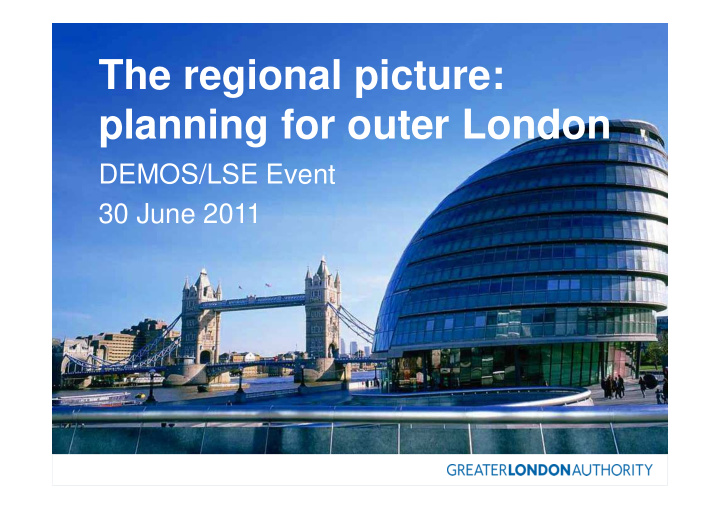



The regional picture: planning for outer London DEMOS/LSE Event 30 June 2011
Why is Outer London important? • Its where 60% of Londoners live • Its where 40% of London’s jobs are • Its where a substantial chunk of London’s development capacity lies • Its an area combining • High accessibility to highly skilled workers • Often (but NOT invariable) high quality of life • Lower costs of doing business than more central areas
Realising potential? Lessons of the past •1919-1939 • London’s population grew by 1.2m (to 8.6m) • NW Middlesex (“Metroland”) by 800,000 •2011 – 2031 • London’s population will grow by 1.3m (to 8.9m) • Particular growth in B&D, Barnet, Havering, Redbridge • Potential for 128,600 homes (40% of identified capacity 2011-21) •BUT • Must not look at OL in isolation; its part of a unique,complex urban system
Lessons of the past •John Betjeman (1906-1984) • “Gentle Brent, I used to know you” (1954) • Brent Cross Shopping Centre (1976) •George Orwell • "a prison with the cells all in a row ... semi-detached torture chambers" • “The place to look for the germs of the future England is in light-industry areas and along the arterial roads. In Slough, Dagenham, Barnet, Letchworth, Hayes - everywhere, indeed, on the outskirts of great towns..”
The London Plan •Mayor’s spatial development strategy • Overall strategic plan for London • Geographic/locational aspects of Mayoral strategies • Londonwide context for borough plans • Policy framework for Mayoral planning decisions
Review of the London Plan •First published 2004; two sets of alterations; consolidated version Feb 2008 •“Planning for a Better London” – setting out Mayoral direction on planning – published for comment July 2008 •Mayor announced complete review of the Plan December 2008 •Initial proposals issued in April 2009 •Draft new Plan issued for consultation 12 October 09 •Consultation closed 12 January 2010
Review of the Plan (2) •944 responses, approximately 7,166 individual comments •Examination in Public • 28 June - 7 December 2010 •Panel report published/”intend to publish” Plan submitted early May
The current Plan’s picture of London
“Planning for a Better London” (July 2008) •“Planning for all of London” a key theme • “..more emphasis needs to be given to issues affecting outer London and ways of realising untapped potential there. As the place where most Londoners live and work it is impossible to meet the challenges facing our city without working to improve the liveability of the huge variety places and neighbourhoods that make up outer London, and to make the most of their potential. Central, inner and outer London are inextricably linked – none can succeed in isolation from the others…” •Establishment of Outer London Commission • To help inform new London Plan policy
The Outer London Commission • Chaired by Will McKee • 14 members – business, local government, development, planning, design, transport, voluntary sector, geographer • Extensive programme of meetings across London • Structured “call for evidence” • Interim report July 2009 • Final report June 2010 • Survey-analysis-plan approach
The Outer London Commission
OLC Recommendations •One size does not fit all •Spatial structure • “Star and cluster” • OL development centres • Cross-boundary working •Demography and housing • Importance of housing in place-making •Economy • Four key sectors: offices; public sector; leisure/arts/culture; retail
OLC recommendations (2) •Transport • “hub and spoke” • Improve modal integration/interchanges • Better network information • Parking and road management •Labour market • Skills •Institutions • GLA Group – and others – need to recognise OL as a spatial priority
The new Plan’s picture of London
The new Plan: a concentric pattern
The new Plan: a polycentric pattern
Plan policies (1) • Policy 2.2: London and wider metropolitan area • Cross-boundary work at all levels on issues like employment, housing, commuting • Policy 2.3: Growth areas and coordination corridors • Potential of Thames Gateway/London-Cambridge- Peterborough growth areas and “coordination corridors” (Western Wedge; Wandle Valley; London- Luton-Bedford)
Plan policies (2) •Policy 2.6: Vision • Realise the potential of OL by recognising and building on its diversity and strengths..enhance quality of life, recognise diversity of neighbourhoods. •Policy 2.7: Economy • Address constraints and opportunities in the economic growth of OL so it can rise above its long-term economic trends – both new and existing sectors
Plan policies (3) •Policy 2.8: Transport • Recognise and address the distinct orbital, radial and qualitative transport needs of OL
Plan policies (4) • Policy 2.16: Strategic outer London development centres • Places with one or more strategic economic functions of greater than sub-regional importance. Egs: •Leisure/culture/sports: Wembley, parts of Greenwich, Richmond/Kingston, Lea Valley, Hillingdon, Wandle Valley •Media: White City, parts of Park Royal •Strategic office: Croydon, Stratford, Brent •Retail: Brent Cross, Stratford
EiP debates • The DRLP should be more specific, particularly about transport investment • We agreed to new text referring to specific actions in the MTS • Need for cross-boundary understanding/work • We agreed to beef up policies on this • Need to refer to importance of housing • We agreed to make this clear • Need to be clearer about SOLDCs • We agreed to be clearer about process for identification, and to emphasise these were to complement existing centres • Panel broadly endorsed approach
The future •Mayor has appointed a new OL Adviser •And is reconvening the OL Commission •He has announced a £50 m town centre fund • Proposals by 18 July! •Future work areas: • SPG: OL and “Shaping Neighbourhoods” • Process for SOLDC designation/development • Housing: design and density
The future (2): the new agenda for the OLC •Advise on supplementary guidance •Development of SOLDC concept/process •Outer London office development • Government offices •Housing density and design •Parking •Rejuvenation of town centres
Questions?
Recommend
More recommend